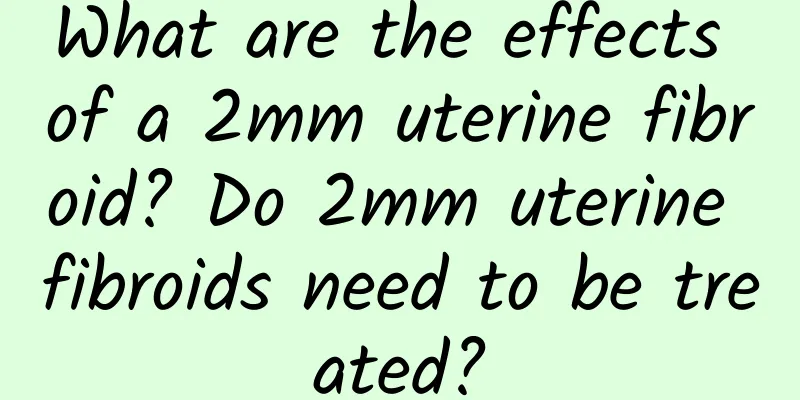What are the effects of a 2mm uterine fibroid? Do 2mm uterine fibroids need to be treated?

|
Uterine fibroids are one of the most common tumors of the female reproductive system. They can grow anywhere in the uterus, including inside and outside the myometrium. Uterine fibroids of different sizes may have different effects on women's physical health. Although 2 mm uterine fibroids are small, they cannot be ignored. So, what are the effects of 2 mm uterine fibroids? Do they need treatment? Let's find out together. Let's answer the first question: What are the effects of a 2 mm uterine fibroid? A 2 mm uterine fibroid is relatively small in size and may not cause noticeable symptoms or affect a woman's daily life. However, this does not mean that it is completely harmless. The main effects of uterine fibroids depend on their location and number. It may cause menstrual problems such as irregular menstruation, prolonged menstruation, and heavy menstrual flow. Some women may experience abdominal pain or a feeling of pressure, especially if the uterine fibroid is located under the endometrium or puts pressure on the uterine wall. Although smaller uterine fibroids are usually benign, they also have the potential to grow and become malignant tumors. So, do 2 mm uterine fibroids need treatment? The answer is not a simple "yes" or "no". 2 mm uterine fibroids are generally not considered a disease that requires immediate treatment, especially for women who have not yet had a health check. Doctors usually recommend regular follow-up and observation to ensure that the uterine fibroids are not growing or causing other problems. If the uterine fibroids have no obvious symptoms and there is no trend of growth after a period of observation, no further treatment may be required. However, everyone's situation is different, and for some women, even small uterine fibroids may cause significant discomfort, and treatment may need to be considered at this time. Popular science on the impact of 2 mm uterine fibroids: Uterine fibroids are tumors formed by abnormal proliferation of muscle cells in the uterine wall. The cause of its occurrence is currently unknown, but it is related to female hormone levels and genetic factors. Although 2 mm uterine fibroids are generally considered small, they also have the potential to grow in the future and have a greater impact on women's health. Therefore, regular follow-up and observation are very important for early detection of the growth trend of uterine fibroids. If there are obvious symptoms or it causes discomfort to women, treatment may need to be considered. Current treatment options include drug therapy and surgical treatment, and the specific method depends on the condition and the needs of the patient. Most importantly, women should have regular gynecological examinations to promptly detect and deal with any possible gynecological problems and maintain good health. Uterine fibroids are a complex health problem, and different sizes of uterine fibroids have different effects on women. Although 2 mm uterine fibroids are small, they also require our attention and attention. Early detection, regular follow-up and observation are very important so that appropriate treatment measures can be taken in time to protect women's health. |
Recommend
What are the self-care measures for pelvic peritonitis?
Everyone knows that the occurrence of pelvic peri...
Tell you what are the main symptoms of uterine fibroids
Among the many gynecological diseases, uterine fi...
How to correctly choose the treatment time for cervical erosion?
How to correctly choose the treatment time for ce...
Eat out to lose weight and eat light hot pot for dinner
Of the three meals a day, dinner is the one that ...
What is the reason for the increase of hcg in laparoscopic surgery for ectopic pregnancy
Ectopic pregnancy is also called ectopic pregnanc...
Super strong! Tips to get rid of back fat in 4 days
The fat on my arms and waist...I wish all the fat...
Don’t give up braised food stalls and buffets when losing weight! Nutritionist: Eat three meals a day and still lose weight
"It's strange, I eat very little for thr...
The most typical symptoms of patients with cervical hypertrophy
Cervical hypertrophy is also a common gynecologic...
What are the items in menopause examination?
I believe that more and more people understand th...
Can I use suppositories to treat inflammation before my period?
Can I use suppositories to treat inflammation bef...
Can I eat before medical abortion? It is best to fast on an empty stomach
Generally speaking, you cannot eat during medical...
What are the common causes of irregular menstruation?
What are the common causes of irregular menstruat...
What diseases can cause pelvic peritonitis?
For women, they will certainly be attacked by som...
Will eating potatoes make you thin? Controlling total calories is key
The stalls selling baked potatoes always have a f...
Does ovarian cyst affect pregnancy?
Do ovarian cysts affect pregnancy? 1. Ovarian cys...









